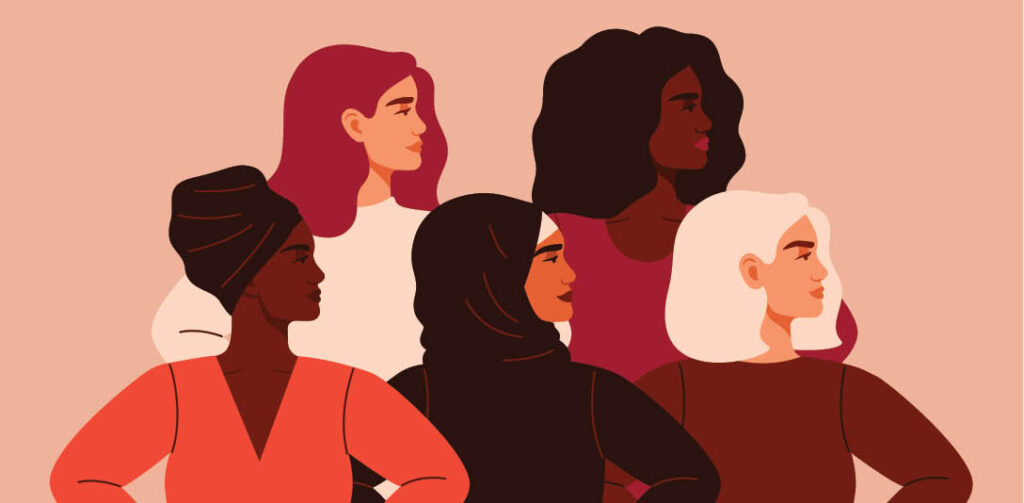Roundtable: Leading While Female: Insights from lived experience

Fewer women than men serve in leadership positions at the secondary school level. To learn what barriers women face in pursuing these roles, the challenges they must navigate once they enter the principalship, and the supports they need to succeed, Principal Leadership contacted Elena Ashburn, central area superintendent for the Wake County Public School System in Cary, NC, former principal of Needham B. Broughton Magnet High School, and the 2022 North Carolina Principal of the Year; Anuradha Ebbe, deputy associate superintendent of middle schools for the Madison Metropolitan School District in Madison, WI, former principal of Cherokee Heights Middle School, and the 2022 Wisconsin Principal of the Year; and Moss Strong, principal of Homedale Middle School in Homedale, ID, and the 2022 Idaho Principal of the Year.
Principal Leadership: What are the specific strengths and characteristics that women bring to the role of school leadership?
Ashburn: Women bring many talents and strengths to positions of leadership. Of course, we know that gender is a little more fluid than strictly binary—man and woman. That being said, I think women tend to be collaborative, they seek to understand, and they are empathetic. When you’re a mother too, you have a good balance of high expectations and the ability to adapt and meet children and people where they are.
Ebbe: Gender differences really depend on context, especially when we think about some of the research that Claude Steele has done related to stereotype threat. In situations where test participants were told that everyone, regardless of race or gender, can succeed on this test, everybody did succeed, but when that information was not provided, people didn’t. Our society is not fair for women, non-binary, and trans people, for example. Often, I think women and people of color have to prove themselves.
Strong: I wonder sometimes if it comes down to empathy, especially as a middle school principal. Girls go through a lot of changes in that time. I think being a woman helps them quite a bit because I, too, was a middle school girl. It’s such a transitional time when young women are identifying who they’re going to be, and we must help them build weaknesses into strengths. Also, with girls in middle school, you will sometimes see an unhealthy friendship or an unhealthy relationship, and female school leaders can help them identify that and work through that.

Principal Leadership: Why do you think there are fewer women than men who serve as middle and high school principals?
Ashburn: There’s a lot of research around this. My dissertation was about the gender gap and the superintendency, and the number one pathway to the superintendency is the high school principalship, which is largely held by men. Also, the job is very demanding of your time. You generally are leading a lot of children and a lot of people. For example, at the school I just left, we had 200 employees, 2,200 students, and all their moms and dads and the community. When you have that many people, the demand on your time is enormous, even when you do have many people who are supporting you, which I did. But there’s still only one principal. Visibility is generally really appreciated at the high school level. You’ve got lots of events that you, as the principal, attend. A real barrier is just the demand on your time. Many women remain the caretakers in their families if they have children, which makes the principalship a challenging job to have. There’s also research around the perception of high school principals being good managers, disciplinarians, and people who are tough. Those are all stereotypes of men and generally not stereotypes of women. These become barriers to the high school principalship for women because the expectation of who the high school principal is and who fits that mold is generally constructed around archetypes of men.
Ebbe: I agree with Elena that it’s related to biases and stereotypes about women. One stereotype is that women are more nurturing. Often, people think that nurturing leaders should be in elementary school with younger children. Then the system is set up where secondary principals tend to go on to district leadership positions. So those opportunities become limited for women.

Strong: At this level, there’s more confrontation. When I talk to my colleagues who are teachers and I’m trying to convince them to pursue school leadership, they say they’re going to get their master’s degree in curriculum and instruction or their content area. I always say, “You should really think about administration.” Then the reply is, “Oh, I don’t want to deal with that stuff. I don’t want to deal with the confrontation that comes with that, the hard conversations.” I don’t know if that’s a gender-specific thing, but that’s usually the part that is swaying a lot of female teachers—who I think would be really good leaders—away from pursuing a master’s degree in education leadership.
Principal Leadership: What supports do you believe women need to succeed as secondary school leaders?
Strong: Well, you’ve got to have some thick skin. I don’t know how you build that. That’s the No. 1 thing for colleagues who have left the profession—and a lot of them are women—the No. 1 thing is whenever you make decisions, you’re going to have someone who’s really happy, and you’re going to have somebody who’s not. That’s emotional, and you carry that baggage. You’ve got to have really thick skin to be able to handle those negative comments that crop up after a decision that you had to make.
Ebbe: When I think about my own journey and some of the principals I’ve mentored, the first thing that comes to mind is family support. Because often, women in our society are asked to take care of the kids at home, asked to do all the cooking, etc. And if you do have a partner, how are you sharing that and really being supportive of one another? The second thing that has been important is the mentorship, coaching, and feedback that is available from people who have similar experiences, especially in my case, women who are leaders of color, being able to talk through things and get some direct feedback. Especially now that we’re facing a principal hiring crisis and staffing shortages in general, it’s really important to think about recruitment and hiring strategies along with retention. How are we partnering with local universities to not only hire and recruit but also write grants that provide stipends for people, especially women, to complete their leadership degrees? Those are some of the things that I think are necessary.

Ashburn: First off, we need allies who are in the role, in the superintendency, on boards of education, etc. I’m not saying women allies necessarily, just allies. I have had many men who have propelled me into the high school principalship who never doubted for a moment that I could do that job. A restructuring too of what the high school principalship is and can be is going to be powerful for women as well, because if we continue to think of the high school principalship as needing toughness and someone who’s a manager of athletics and money, then those barriers will continue to keep women from that role.
We also need ways that women can adequately do the job and be mothers at the same time. If we want more women in the principalship, and in particular the high school principalship, we’ve got to provide some supports there. We could ensure that women receive childcare as a benefit or a job schedule that’s more flexible. I’m definitely an anomaly. I became a middle school principal at a young age (28) and then went into the high school principalship pretty quickly and had two babies while I was in the job. The research shows that most women enter leadership roles much later in their life, which is why we see women choosing to be superintendents almost at the end of their careers or when they have 30 years of experience already. If we want more women in the role, we’ve got to make sure the entry point is at a younger age.
Principal Leadership: How has being a woman shaped your own career?
Ebbe: I was born and brought up in India. Gender roles were quite divided in the community and in my family. I had to fight for things, like being able to ride a bike. My mom had to really stand up for me in front of many people in the community to allow me to ride a bike. It was such a shameful thing for women at that time. Things are different now. Just having that experience and knowing the experience of my mom, who finished seventh grade and married my dad at 16, has shaped me. My mom knew she wanted something different for us and my dad did, too. My sister and I were first-generation college-goers among the women in my family, and so I have a passion for education because it has led to many opportunities and freedom for me and my family. When I think about the purpose of education, it’s really to liberate. Educate to liberate is something we’re really leaning into in our district, so we can build new systems that support all marginalized communities and all marginalized students.
Strong: My path has always been to impact the educational system to make it great for kids. Growing up, I had a pretty rough home life. School was always kind of my safe place, and I had teachers who really cared for me, and that left a lasting impact on me. Those caring people changed my life, so I went into education with the goal of helping kids and having that impact. I felt like I could only reach my classroom as a teacher, and I knew there was so much more I could do. So, I pursued my ed leadership degree in the hopes of becoming a principal. At that time, I was pregnant and had a three-year-old, and I was coaching track and cross country. I really put a lot on my plate. I must like that because I still do it to this day. When I’m constantly knee-deep in a lot of different things, that’s where I’m happy.
Ashburn: I see my career in two phases. There was phase one of my principalship where I was so ambitious that I was willing to put everything else on the back burner, including having a second child. During that phase, I also acted like a man frequently. I would have never admitted it then, but I did. I acted tougher than I would. I was meaner in some situations than I would naturally be, etc. And then there was phase two. Once I got a couple years under my belt and had some allies and had some frank conversations with people who supported me, I kind of shifted and I began to see being a woman and a mother as an asset and not a deficit. In fact, I totally flipped my whole mindset. I credit my current superintendent for a lot of that. When I went into the high school principalship, she was a woman high school principal who had children. She kind of gave me permission to say when you have nighttime events or you have community things, just bring your kids with you. My kids grew up in the gym. She was giving me permission to visibly be a mom. I just kind of leaned into who I was, and that has been life-changing.
Principal Leadership: How have you or your district engaged in specific practices around supporting women as middle and high school principals?
Ebbe: We’re mindful about going to colleges where there are more opportunities to recruit women and women of color. We go to Historically Black Colleges and Universities and colleges that graduate bilingual candidates. When we put teachers and leaders in front of students who look like them, there’s so much research that shows that really leads to amazing student outcomes. Then the retention piece of that is mentoring and creating the pipeline. There’s a grow our own program that we have created to support our noncertified staff to become teachers. And then I have recruited educators within my own Indian community because there really aren’t that many K–12 educators of Indian descent. We have a temple where I connect with members of my community, and a lot of it is through word of mouth.
Strong: Building leadership within our district is definitely a focus. Personally, as a leader, if I have somebody in my building who says they’re going to go get their master’s degree, I often say they should consider a degree in administration, especially if they have that skill set where I think they would be a great leader. And most of my teachers do have that skill set because we’ve developed that leadership. Especially where I lead in a rural district, you’ve got to have that extra leadership because you don’t have the depth of support systems like the larger school districts.
Ashburn: There are more women in positions of power in my district, and that is a huge change. It’s almost like once you can get a couple of people to move into those positions, inevitably they’re going to nurture and mentor other women so that’s what I try to do. I try to spot women and encourage them and their talents. You can’t do that without relationships. First and foremost, as a high school principal, you need to know your staff well enough to know who could move to the principalship. Trying to nurture that talent is really important. You also need to make sure you’re intentional in your hiring and that you have a balance of voice and representation.
Principal Leadership: Why do you think it’s important for students and staff to see women as secondary school leaders?
Ashburn: Seeing someone in the role is a concrete example that it’s possible. I cannot tell you how many girls and parents in my school would talk to me about my being a mother. That was a frequent point of conversation. It was a validation of who I am, a validation that we come into these leadership roles as our whole self, and we’re not just fitting into a mold.
Ebbe: When students see themselves in their school leaders and teachers, that makes a big difference. That’s one piece of it. The other piece is that, in the future, we want our students to consider going into education and becoming secondary school leaders. So, seeing women and people of color in those roles is very inspiring. A lot of times I’ve had students come to me and say, “You’ve inspired me to go into education.” Some of my students are now educators in my school district. I am truly proud of that.
Strong: It’s important for kids to see that women can take on both roles as a caretaker and as a leader. I think about some of the notes I have received from students here at this middle school. One really impacted me this year around Thanksgiving. A young girl wrote me a note that said, “You really inspire me because I see you as a strong woman who leads lots of people in a positive direction, and I want to be like you one day.” It meant so much to me that she wrote this note because she comes from a background where there isn’t a lot of strong female leadership in her family. Hopefully I’m inspiring young women to see the potential of what they could be—that they can balance these roles and be great at all of them.
